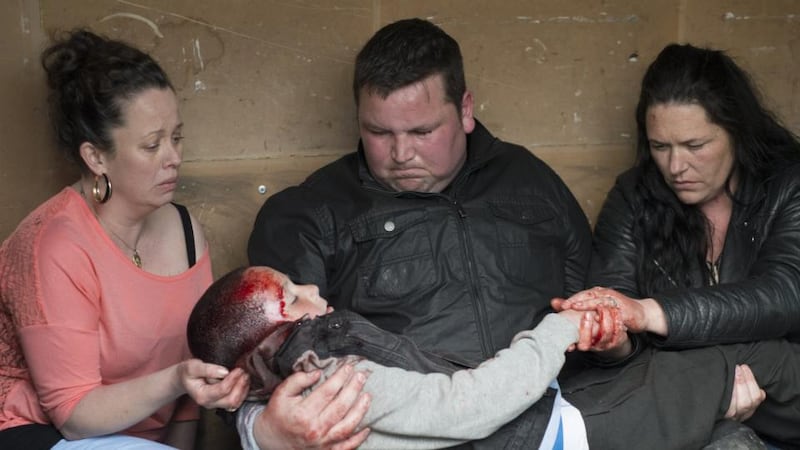John Connors has felt a rage within him since he was a child, he says. It's hard to believe when you first meet him. He is gently spoken and greets this writer with a broad smile and a hug.
The actor, whose character Patrick shot Nidge in the finale of the TV series Love/Hate, personifies much of the complexity of Traveller identity. It is an identity he explores in some detail in a documentary he fronts, to be screened on RTÉ next week.
In the opening sequence of I Am Traveller the 26-year-old introduces us to his home. Despite having achieved success in mainstream society, and having lived in a house for more than 15 years, he moved back to a trailer and to the camp where he had had a "wonderful childhood", in Darndale, in north Dublin, last year.

“This is my home. This is part of my identity,” he tells us. “Since I was a child I have had people call me ‘knacker’. It hurts and it builds and it makes me angry. But I’m not going to give that word any power any more. I am not a knacker. I am Traveller.”
Twice during conversations with The Irish Times this week – we're in a canteen at University College Dublin, where he is researching another documentary – he obliges charmingly as groups of young women asks for selfies with him.
"I get this all the time," he says, smiling. "Even in New York I got people coming up to me, Irish people living there, saying, 'I loved Love/Hate,' calling me Patrick."
But a woman at a charity event once asked him if he was really an “itinerant”, remarking how “weird” it was that an “itinerant” could be an actor.
“I just shrugged at her,” he says. “I know there is a huge number of people who just don’t want to get beyond the stereotype – that being a Traveller means you could never achieve anything. To them I am weird.
“You get it from the moment you’re born, as a Traveller, society telling you you’ll amount to nothing – and that does build up in you as a rage, that you will never be accepted, that no matter what you do as an individual you will always be the same to them: a drunken, thieving, smelly knacker.”
Born in London, Connors returned to Ireland with his parents when he was 11 months old. He has two brothers. His father, who suffered with depression and schizophrenia, took his own life when John was eight.
Around this time, he remembers, he got into a fight with a boy in his class. The teacher grabbed him, he says, and threw him down, calling him a “dirty, smelly knacker”.
“I’ll never forget that: the realisation I would always be blamed and that the teacher, or maybe anyone who wasn’t Traveller, would never back me.”
He left school when he was 15 – as soon as he could. He says that there was peer pressure to leave and that, despite his mother’s pleas, he would have “felt like a big eejit” if he had stayed on. He became depressed; when he was in his late teens his brother suggested that he try to get into acting, given his interest in films. He contacted the school of acting at the Abbey Theatre and found he was good at it.
The intention in this documentary, directed and produced by Kim Bartley, is to explore the fraught relationship between the Traveller and settled communities, from a Traveller perspective. It looks at the reasons for the hostility, examining the beliefs in the settled community about Travellers and in the Traveller community about the settled community – or “country people”, as Travellers call them.
More compelling, perhaps, is his exploration of where his community is at in 2016: at once full of pride, rage and shame. We meet a community in crisis on many levels, with its young men in particular experiencing a devastating crisis of identity.
Difficult issues
There is no flinching from the difficult issues. The mainstays of much media coverage of Travellers are tackled: the feuding, the bare-knuckle boxing, the poverty, the low educational attainment, the high unemployment (up to 80 per cent among men) and the staggering suicide rates (six times the rate of the settled community).
But the programme also refuses to apologise for them. In one sequence Connors is interviewed on radio by Ray D'Arcy about his role in Love/Hate. Listeners call in to ask about criminality and feuding among Travellers. "Is there a lot of internal fighting within the Traveller community?" asks D'Arcy. There is internal feuding, answers Connors, engaged in by "probably less than 10 families". You don't hear about the vast majority who aren't feuding, because they're not feuding, he adds.
In his narration for I Am Traveller Connors comments: "When other actors in Love/Hate were interviewed they'd be asked about Hollywood or who they'd like to ask to a fantasy dinner party. Every interview I do is the same thing. I am asked to account for Traveller violence and feuding. I have never been involved in a feud."
He hates the feuding, he says; it disgusts him and hurts Traveller families. In the documentary he talks to a Traveller mediator who points to how the internet, especially YouTube, and gambling have intensified some of the feuding but also to how mediation can work.
Media coverage
Connors discusses crime among Travellers with the crime journalist
Paul Williams
, putting it to him that media coverage of rural crime has implied that it is being run by “Traveller gangs”.
Williams argues that some Travellers are involved in rural crime and tells Connors that his community is “being let down by the criminal element all the time”. Society bears some responsibility, says Williams, “but it is also your fault as an ethnic grouping”.
He asks Connors: “When is the Traveller community going to really come out? When are they going to go up and march on the streets and say, ‘We want the drug dealers, the rapists, the people who are terrorising our own people, we want them f***ed out’?”
In his narration Connors responds: “Why should I protest about a gang of drug dealers who have nothing to do with me? I’ll take responsibility for things I can control.”
He says he will work to tackle depression, low educational attainment and high suicide rates in his community, things he believes he can change.
At their root, he argues, is poverty, State oppression and the continuing crisis of identity five decades after the 1963 government's Report of the Commission on Itinerancy, which referred to the "problem of itinerants", and how best to achieve their "absorption into the general community", and gave serious consideration to the "solution" of "itinerant children being taken from their families and placed in institutions".
Legislation since then has prevented travelling, even during the summer, and the failure of most local authorities to provide sufficient Traveller-specific accommodation – for which Travellers would pay rent like all other tenants – has forced thousands of families into “settled” rented accommodation.
“Travelling has been taken away from us by the State. Our identity has been denied. That has allowed people to dehumanise us.”
Connors talks to Traveller girls about being bullied at school and to a 15-year-old about why he has left school. “I can’t make friends in there . . . They wouldn’t hang around with you, give you dirty looks. They were calling me names . . . I’d prefer to be at home,” he tells Connors.
Although many older Travellers feel more secure in their identity, a lot of younger Travellers are struggling, he says, conflicted about where they fit in.
A group of young men talk about the pressures from peers to leave school early and from others to marry young. If you’re not married by 25, says one, people think you’re gay.
He describes the difficulties Travellers face getting work, because of prejudice. Many will hide their Traveller identity to get work, even hiding it all their adult lives.
Halting site fire
While Bartley and Connors were making the documentary 10 people, including five children and a young pregnant mother, died in the fire at a temporary halting site in south Dublin. Protests by settled residents against plans to accommodate the grieving survivors shocked Connors.
He has “hardly scratched the surface” of just how deep hatred toward Travellers could be.
One of the survivors, a 15-year-old whose name is also John Connors, brings Connors back to the site of the fire. He describes getting five-month-old Mary Connors – who subsequently died in hospital – and four-year-old Thomas Connors out of the blaze.
“I don’t think I’ll ever get a proper sleep again after what happened . . . I can’t say, ‘Yes, my future is going to be deadly.’ It surely won’t be.”
Things need to change within his own community, says Connors. For a start the rage within must be quietened with acceptance. “It is clear to me that without formal recognition of our identity, and a willingness on both sides to confront stereotyping and discrimination, real change will be a long time coming.”
I Am Traveller is on RTÉ2 on Thursday, March 24th, at 9.30pm










